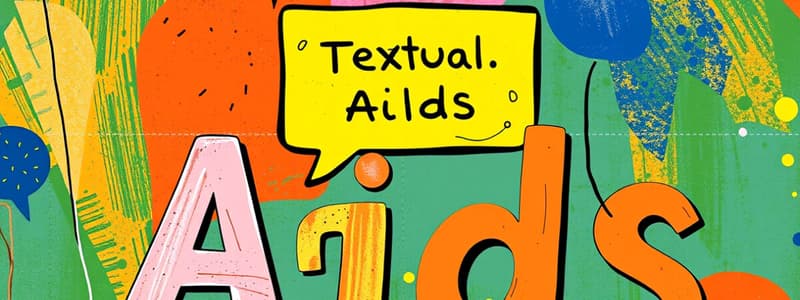Podcast
Questions and Answers
What is the primary purpose of headings and subheadings in written content?
What is the primary purpose of headings and subheadings in written content?
- To prioritize text length
- To highlight key points
- To organize content and indicate main ideas (correct)
- To simplify complex information
Which type of graphical representation is specifically designed to show trends and comparisons?
Which type of graphical representation is specifically designed to show trends and comparisons?
- Maps
- Charts and Graphs (correct)
- Diagrams
- Images and Photographs
How do bullet points enhance written content?
How do bullet points enhance written content?
- By complicating the structure
- By simplifying information and highlighting key points (correct)
- By emphasizing definitions
- By indicating main ideas
What is a benefit of using graphics in conjunction with textual aids?
What is a benefit of using graphics in conjunction with textual aids?
Which of the following types of textual aids is best for showing sequence or ranking?
Which of the following types of textual aids is best for showing sequence or ranking?
What is one advantage of using diagrams as graphics?
What is one advantage of using diagrams as graphics?
What role do footnotes serve in written content?
What role do footnotes serve in written content?
In which scenario would combining textual aids and graphics be particularly beneficial?
In which scenario would combining textual aids and graphics be particularly beneficial?
Flashcards are hidden until you start studying
Study Notes
Uses of Textual Aids
-
Definition: Textual aids are tools that enhance understanding of written content.
-
Types:
- Headings and Subheadings: Organize content, indicate main ideas.
- Bullet Points: Simplify information, highlight key points.
- Numbered Lists: Show sequence, steps, or rankings.
- Bold/Italics: Emphasize important information or terminology.
- Footnotes/Endnotes: Provide additional details without cluttering the main text.
-
Benefits:
- Clarity: Makes information easier to digest.
- Focus: Attracts attention to essential concepts.
- Retention: Enhances memory recall through structured formats.
- Navigation: Facilitates easier location of information within texts.
Uses of Graphics
-
Definition: Graphics are visual representations that support textual information.
-
Types:
- Charts and Graphs: Present data visually, showing trends and comparisons.
- Diagrams: Illustrate processes, structures, or relationships.
- Images and Photographs: Provide real-world context or enhance emotional understanding.
- Maps: Convey geographical information or spatial relationships.
-
Benefits:
- Visual Appeal: Captures interest and engages the audience.
- Simplification: Breaks down complex information into understandable visuals.
- Illustration: Supports or clarifies textual information, aiding comprehension.
- Memory Aid: Visuals can enhance recall through association.
Integration of Textual Aids and Graphics
- Enhanced Communication: Combining both aids improves overall understanding and retention.
- Multi-Sensory Learning: Engages different learning styles, making information accessible to a wider audience.
- Contextual Support: Graphics can provide context for textual information, reinforcing the message.
Application
- Educational Materials: Textbooks, presentations, and online content often use both to facilitate learning.
- Business Reports: Often incorporate both to present findings and recommendations convincingly.
- Marketing: Use graphics and text to attract interest and convey messages effectively.
Uses of Textual Aids
- Textual aids enhance understanding of written materials, making it easier for readers to process information.
- Headings and subheadings help organize content and indicate main ideas, guiding readers through the text.
- Bullet points simplify information by highlighting key points, making it more digestible.
- Numbered lists are effective in showing sequences, steps, or rankings, allowing for clearer comprehension.
- Bold and italics draw attention to important information and terminology, emphasizing crucial concepts.
- Footnotes and endnotes provide additional details without cluttering the main text, allowing for deeper exploration of topics.
- The use of textual aids contributes to clarity, making complex information more manageable for readers.
- Textual aids help maintain focus by attracting attention to essential concepts, improving engagement.
- Structured formats using textual aids enhance memory recall, aiding long-term retention of information.
- These aids facilitate easier navigation within texts, allowing readers to locate information quickly.
Uses of Graphics
- Graphics serve as visual representations that support and enrich textual content, enhancing overall comprehension.
- Charts and graphs visually present data, effectively showcasing trends and comparisons for better analysis.
- Diagrams illustrate processes, structures, or relationships, helping to clarify complex ideas or systems.
- Images and photographs provide real-world context and can enhance emotional understanding of topics discussed.
- Maps convey geographical information or spatial relationships, offering insights into location-based concepts.
- Graphics capture interest and engage audiences, adding visual appeal to the material presented.
- Visuals simplify complex information, transforming it into more understandable and relatable formats.
- Graphics provide an illustration for textual information, supporting clarity and comprehension of written content.
- The use of visuals aids in memory recall by creating associations, making information more memorable.
Integration of Textual Aids and Graphics
- Combining textual aids and graphics improves communication significantly, enhancing overall understanding and retention rates.
- This integration supports multi-sensory learning, engaging different learning styles and catering to diverse audiences.
- Graphics provide contextual support for textual information, strengthening and reinforcing key messages delivered in writing.
Application
- Educational materials like textbooks, presentations, and online content often utilize both textual aids and graphics to facilitate effective learning.
- Business reports commonly incorporate both elements to present findings and recommendations in a persuasive manner.
- In marketing, the combination of graphics and text effectively attracts interest, conveys messages, and promotes engagement with the audience.
Studying That Suits You
Use AI to generate personalized quizzes and flashcards to suit your learning preferences.




